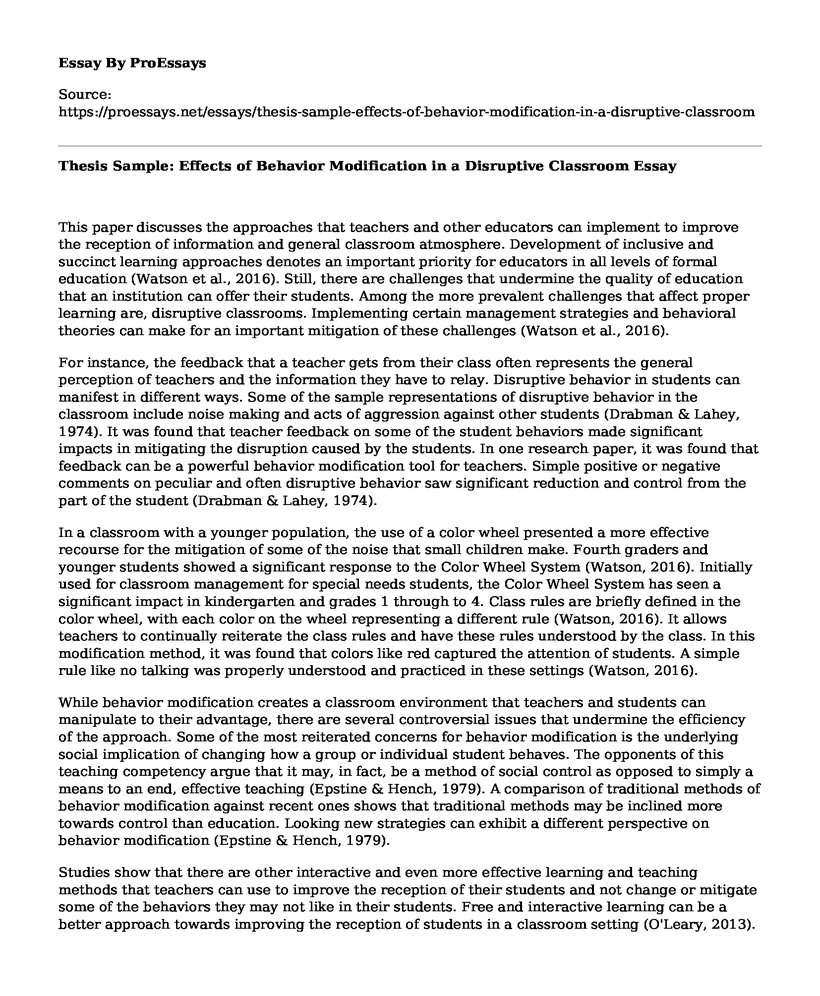This paper discusses the approaches that teachers and other educators can implement to improve the reception of information and general classroom atmosphere. Development of inclusive and succinct learning approaches denotes an important priority for educators in all levels of formal education (Watson et al., 2016). Still, there are challenges that undermine the quality of education that an institution can offer their students. Among the more prevalent challenges that affect proper learning are, disruptive classrooms. Implementing certain management strategies and behavioral theories can make for an important mitigation of these challenges (Watson et al., 2016).
For instance, the feedback that a teacher gets from their class often represents the general perception of teachers and the information they have to relay. Disruptive behavior in students can manifest in different ways. Some of the sample representations of disruptive behavior in the classroom include noise making and acts of aggression against other students (Drabman & Lahey, 1974). It was found that teacher feedback on some of the student behaviors made significant impacts in mitigating the disruption caused by the students. In one research paper, it was found that feedback can be a powerful behavior modification tool for teachers. Simple positive or negative comments on peculiar and often disruptive behavior saw significant reduction and control from the part of the student (Drabman & Lahey, 1974).
In a classroom with a younger population, the use of a color wheel presented a more effective recourse for the mitigation of some of the noise that small children make. Fourth graders and younger students showed a significant response to the Color Wheel System (Watson, 2016). Initially used for classroom management for special needs students, the Color Wheel System has seen a significant impact in kindergarten and grades 1 through to 4. Class rules are briefly defined in the color wheel, with each color on the wheel representing a different rule (Watson, 2016). It allows teachers to continually reiterate the class rules and have these rules understood by the class. In this modification method, it was found that colors like red captured the attention of students. A simple rule like no talking was properly understood and practiced in these settings (Watson, 2016).
While behavior modification creates a classroom environment that teachers and students can manipulate to their advantage, there are several controversial issues that undermine the efficiency of the approach. Some of the most reiterated concerns for behavior modification is the underlying social implication of changing how a group or individual student behaves. The opponents of this teaching competency argue that it may, in fact, be a method of social control as opposed to simply a means to an end, effective teaching (Epstine & Hench, 1979). A comparison of traditional methods of behavior modification against recent ones shows that traditional methods may be inclined more towards control than education. Looking new strategies can exhibit a different perspective on behavior modification (Epstine & Hench, 1979).
Studies show that there are other interactive and even more effective learning and teaching methods that teachers can use to improve the reception of their students and not change or mitigate some of the behaviors they may not like in their students. Free and interactive learning can be a better approach towards improving the reception of students in a classroom setting (O'Leary, 2013). Laughing and singing alongside serious course work makes for an interesting and memorable learning experience. In this study, the effects and impact of behavior modification are detailed and challenged respectively (O'Leary, 2013).
References
Drabman, R. & Lahey, B. (1974). Feedback in classroom behavior modification: effects on the target and her classmates1. Journal Of Applied Behavior Analysis, 7(4), 591-598. http://dx.doi.org/10.1901/jaba.1974.7-591
Epstein, & Hench, C. (1979). Behavior Modification in the Classroom: Education or Social Control. Journal Of Sociology And Social Welfare, 6(5). Retrieved from http://htp://scholarworks.wmich.edu/jssw/vol6/iss5/3
O'Leary, K. (2013). Behavior modification in the classroom: a rejoinder to Winett and Winkler1. Journal Of Applied Behavior Analysis, 5(4), 505-511. Retrieved from http://onlinelibrary.wiley.com/doi/10.1901/jaba.1972.5-505/full
Watson, T. (2016). The Effects of the Color Wheel on Disruptive Behavior in Class Room Climate.Validating the Color Wheel in Kindergarten Classrooms. (Ph.D.). University of Tennessee.
Watson, T., Skinner, C., Skinner, A., Cazzell, S., Aspiranti, K., Moore, T., & Coleman, M. (2016). Preventing Disruptive Behavior via Classroom Management. Behavior Modification, 40(4), 518-540. http://dx.doi.org/10.1177/0145445515626890
Cite this page
Thesis Sample: Effects of Behavior Modification in a Disruptive Classroom. (2021, Apr 16). Retrieved from https://proessays.net/essays/thesis-sample-effects-of-behavior-modification-in-a-disruptive-classroom
If you are the original author of this essay and no longer wish to have it published on the ProEssays website, please click below to request its removal:
- Essay Sample on Emergent Bilinguals Education Policy
- Incidents in the Life of a Slave Girl Book Review
- Explain the Functions of Assessment in Learning and Development
- Essay on Video Gaming: A Powerful Tool for Child Development?
- Essay Sample on Living By Values: Improving My Social & Working Life
- Paper Example on Sensory Experience & Customer Loyalty: Analyzing Factors Correlating to Loyalty
- Mental Health Consultation Essay Example







